
Eduard 1/48 Spitfire Vb Floatplane
| KIT #: | 82156x |
| PRICE: | $22.95 |
| DECALS: | None supplied |
| REVIEWER: | Tom Cleaver |
| NOTES: | Gartex Spitfire Floatplane GA-6 conversion |

| HISTORY |
The Spitfire was the descendant of racing seaplanes. As the war developed, it appeared there were places where a high performance seaplane fighter might be useful, which led to the development of a modified Spitfire Vb with landing gear removed and replaced by twin floats known as the Type 355.
The first time such a conversion was brought up was at the outbreak of the 1940 Norwegian campaign, where the RAF found itself at a disadvantage against the Luftwaffe, with very few airfields to operate from during the German invasion. Folland Aircraft undertook the conversion of a Spitfire I, R6722, known as the “Narvik Nightmare,” using Blackburn Roc floats. However, the Norwegian campaign was over before further development of such a fighter could take place and the airplane was returned to Mk.I configuration.
The idea resurfaced in 1942, following a report from Folland Aircraft,
which had continued working on the concept even after cancellation. This time a
Spitfire Vb, W3760, was used for the conversion and used floats designed by
Arthur Shirvall, who had created the high speed floats used on the S.4., S.5,
S.6A and S.6B racing seaplanes. The initial flight took place on October 12,
1942 in Southampton harbor, with the standard
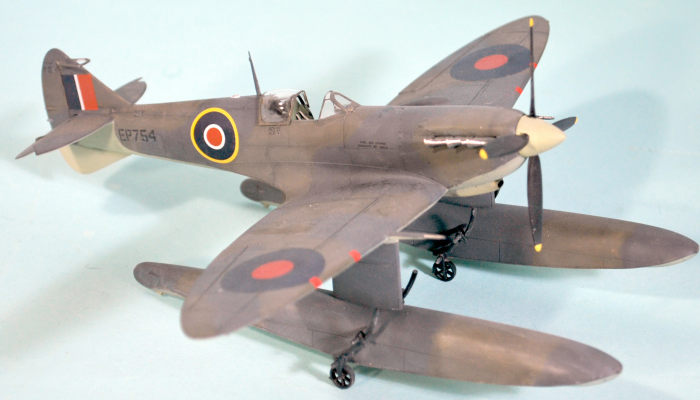 carburetor
intake initially replaced with a tropical Vokes filter, but this did not protect
against water ingestion during takeoff and landing, and a smaller intake was
developed that did keep water out. It was also found necessary to enlarge and
extend the vertical fin and rudder and a larger ventral fin was added for
directional stability. Following these modifications, the prototype began
further tests in Glasgow in January 1943.
carburetor
intake initially replaced with a tropical Vokes filter, but this did not protect
against water ingestion during takeoff and landing, and a smaller intake was
developed that did keep water out. It was also found necessary to enlarge and
extend the vertical fin and rudder and a larger ventral fin was added for
directional stability. Following these modifications, the prototype began
further tests in Glasgow in January 1943.
Fully loaded, the seaplane weighed only 1,100 lbs more than a standard Spitfire Vb, and maximum speed was only reduced 40 mph, to 324 mph at 19,000 feet. Maneuverability with the floats was only slightly less than a standard Spitfire and it was found to be more maneuverable than any other seaplane.
In the summer of 1943, planning began for an operation using the Spitfire seaplane against the Germans in the Dodecanese Islands off the coast of Turkey. This unit would be dependent for supply on air transport, and the plan was to use the Spitfire seaplanes operating from a small, uninhabited island to attack German aircraft, with a submarine used as a base. Folland was issued a contract to convert two more Spitfire Mk.Vb’s, EP751 and EP754.
The three Spitfire seaplanes were transferred to Egypt, arriving at the base at Kasfareet, were the prototype W3760 remained crated after serious corrosion was found in the tail unit, while EP751 and EP754 were assembled by 107 Maintenance Unit and taken to the old prewar seaplane station at Fanara on the Great Bitter Lake in November 1943, where they would be operated. The unit was equipped with a 40-foot high speed launch powered by two 100hp engines, an all-purpose 22-foot seaplane tender powered by a Ford V8, and a steam-operated crawler crane to lift the seaplanes onto the concrete dock. A Walrus was provided for initial seaplane training for the pilots. Five high-time Spitfire pilots were chosen for the unit, led by Flying Officer William Lindsay. Training proceeded and the pilots were easily able to fly the Spitfires after a minimum of experience with the Walrus.
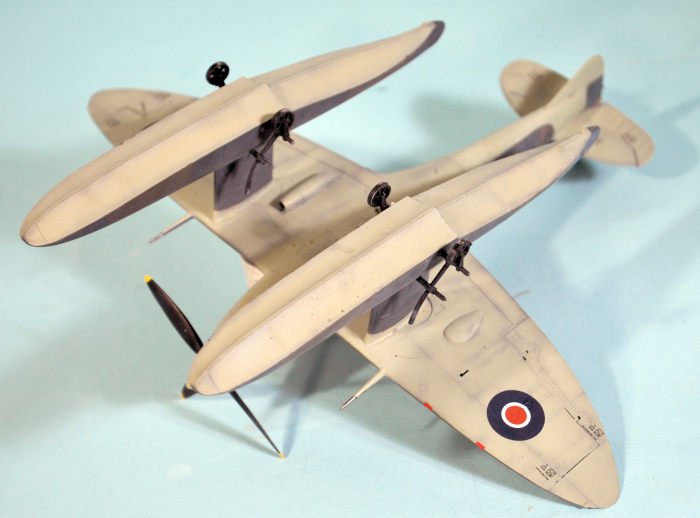 Unfortunately,
during training it was found that the floats leaked enough that the aircraft had
to be hauled out of the water to allow them to drain. While this was not an
issue at the seaplane base, it would be a serious issue at a submarine mooring
near a small island in the Dodecanese Islands, where it would not be possible to
haul the airplanes out of the water. It was also found to be virtually
impossible to take off in crosswinds over 15 mph. It was finally found
impossible to discover a suitable "secret" location in the Dodecanese Islands
that would allow flexible takeoffs. The Royal Navy was not enthusiastic at all,
since they saw it as an operation that would inevitably require surface units to
rescue the aircraft once the base was discovered. After the Germans occupied the
area and stationed JG 27 with BF-109G6 fighters in the archipelago, the plan was
abandoned. With no other operational use found for the airplanes, they were
disassembled, re-crated and returned to Kasfareet, where they were eventually
returned to Britain and put in storage.
Unfortunately,
during training it was found that the floats leaked enough that the aircraft had
to be hauled out of the water to allow them to drain. While this was not an
issue at the seaplane base, it would be a serious issue at a submarine mooring
near a small island in the Dodecanese Islands, where it would not be possible to
haul the airplanes out of the water. It was also found to be virtually
impossible to take off in crosswinds over 15 mph. It was finally found
impossible to discover a suitable "secret" location in the Dodecanese Islands
that would allow flexible takeoffs. The Royal Navy was not enthusiastic at all,
since they saw it as an operation that would inevitably require surface units to
rescue the aircraft once the base was discovered. After the Germans occupied the
area and stationed JG 27 with BF-109G6 fighters in the archipelago, the plan was
abandoned. With no other operational use found for the airplanes, they were
disassembled, re-crated and returned to Kasfareet, where they were eventually
returned to Britain and put in storage.
The idea of the Spitfire on floats did not die. It was resurrected in 1944 as a possibility for support of invasions in the Pacific, and Spitfire IX MJ982 was modified as a seaplane and flown in June 1944. However, the plan died since by this time the American island-hopping campaign had demonstrated that there would be fewer amphibious operations and that they were easily supported by aircraft carriers.
The four Spitfire seaplanes were struck off charge at the end of the war and were all broken up.
| THE KIT |
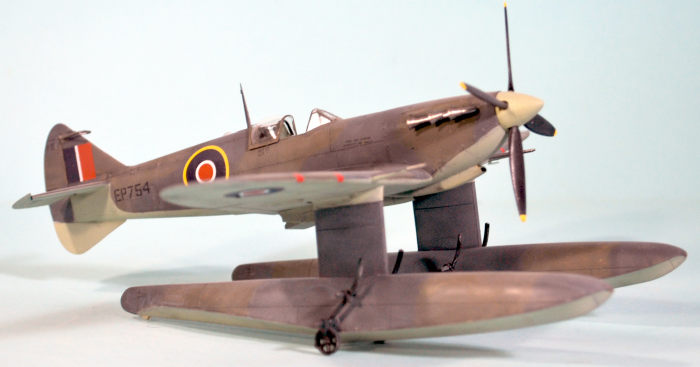 The
only good kit of the Spitfire Vb floatplane ever released in 1/48 came from
Gartex, a sub-set of Hasegawa, which was released around 1995. The kit featured
the then-new Hasegawa Spitfire Vb plastic kit, the first “good” 1/48 Spitfire
kit, with a resin tail that included the larger vertical fin, larger rudder and
ventral fin, a resin lower nose part providing the different carburetor intake,
resin floats, resin float bases, and white metal propeller blades.
The
only good kit of the Spitfire Vb floatplane ever released in 1/48 came from
Gartex, a sub-set of Hasegawa, which was released around 1995. The kit featured
the then-new Hasegawa Spitfire Vb plastic kit, the first “good” 1/48 Spitfire
kit, with a resin tail that included the larger vertical fin, larger rudder and
ventral fin, a resin lower nose part providing the different carburetor intake,
resin floats, resin float bases, and white metal propeller blades.
Eduard released their 1/48 Spitfire Vb (late) this past August, and relased Overtrees kits a few weeks later. This Spitfire kit is the best so far, with superb surface detail and full accuracy for the late-production Spitfire Vb with the integral armor glass windscreen.
| CONSTRUCTION |
I found this Gartex floatplane kit at the LHS estate sale in summer 2020, just after the shop reopened from the Covid-19 shot-down. At a price of only $50 (the kit goes to collectors for around $150) it was “an offer I could not refuse.”
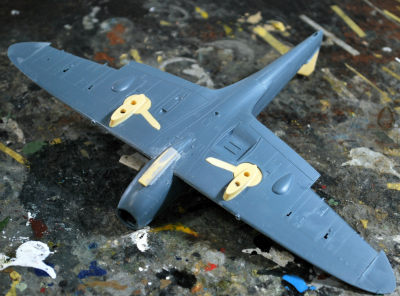 Opening
the box on returning home, I discovered that time has not been kind to the
Hasegawa Spitfire; I guess that’s why they no longer release it. But the resin
parts are still wonderful. I put it aside, to “await further developments.”
Opening
the box on returning home, I discovered that time has not been kind to the
Hasegawa Spitfire; I guess that’s why they no longer release it. But the resin
parts are still wonderful. I put it aside, to “await further developments.”
A year later, Eduard came out with their Spitfire Vb series which I really liked when I built on. The Overtrees showed up on eBay at a nice price and I ordered two. Looking through one of my Spitfire books, I ran across the floatplane again. I wondered if a model could be created mating the reaqlly great Eduard kit to the the really nice Gartex resin.
While awaiting the arrival of the kits, I fiddled with the resin and an
Eduard Spitfire II kit, checking possible fit. It turns out, the Hasegawa rear
fuselage really is too narrow (like 1/16 inch difference with an Eduard kit -
that’s noticeable in 1/48). And then it hit me I could do what Folland did when
they built the original floatplanes: add on a new vertical fin, a new rudder,
and new ventral fin. All I had to do was cut the vertical and ventral fins and
the rudder off the Gartex tail plug - fortunately, both kits had the same
profile size. As to the floats, a little bit of sanding of the resin plugs for
the float mounts had them fitting the lower Eduard wing. The resin lower nose
wasn’t going to work, but it wouldn’t
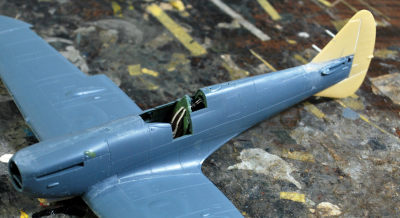 be hard
to cut off the intake and make it fit the Eduard part.
be hard
to cut off the intake and make it fit the Eduard part.
When the kits arrived, I was primed and ready.
All I had to do was cut off the vertical fin from the Eduard kit along a panel line. Once the fuselage was assembled, the three resin parts fitted like charms, with just some Mr. Surface 500 to fill the join seams for the fins. The float pylon attachment bases fit into the lower wing like they were meant to. The carb intake was glued to the lower nose and Mr. Surfacer filled that joint. Outside of waiting for the Mr. Surfacer to set thoroughly before sanding smooth, the entire business took under 45 minuts.
Once again, I attached the lower wing to the fuselage, getting a nice tight fit, then glued the upper wing parts in position. No the fuselage, then attach the upper wing. No “industrial strength pushing and shoving” and overall better fit. I shall follow that with all Eduard Spitfires from now on.
The rest of the project was easy – attach the horizontal stabs, the gunsight, and the windshield. I then attached the floats. The one difficult part was when Miss Molly decided to make the spinner for the 4-blade prop a kitty toy. Fortunately, Andy Abshier had a spinner from and ICM Spitfire that worked perfectly and looks better than the Gartex original.
| COLORS & MARKINGS |
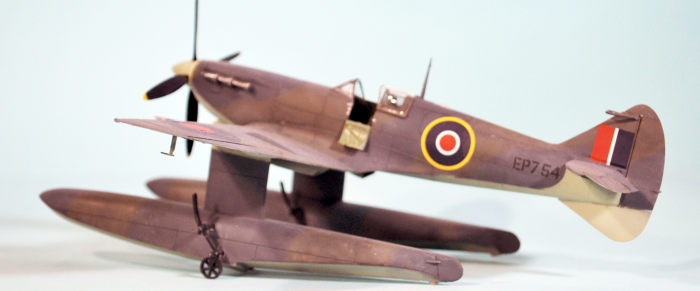 Photos
of the Spitfire floatplanes show them dark enough that I decided it was likely
they were painted in the Temperate Sea Scheme - Extra Dark Sea Grey, Dark Slate
Grey, and Sky. I used my Xtracrylix paints and freehanded the scheme with my
Paasche-H.
Photos
of the Spitfire floatplanes show them dark enough that I decided it was likely
they were painted in the Temperate Sea Scheme - Extra Dark Sea Grey, Dark Slate
Grey, and Sky. I used my Xtracrylix paints and freehanded the scheme with my
Paasche-H.
I used decals from the Spitfire Decals wing of the Decal Dungeon, piecing togethet the serial number.
I attached the white metal beaching gear to the floats, attached the prop, the cockpit flap and canopy in the open position, and the exhaust stacks.
| CONCLUSIONS |
The Spitfire floatplane is popular with modelers. Eduard ought to do a limited-release of their kit, with 3D printed floats and the rest. Mounting the airplane on floats sends it back to its Schneider Cup origins. If you have one of the Gartex kits way back in the corner of the stash closet, pull it out and do this. It’s easy to mount the best Spitfire kit to the great resin parts.
20 October 2021
Copyright ModelingMadness.com. All rights reserved. No reproduction in part or in whole without express permission.
If you would like your product reviewed fairly and fairly quickly, please contact the editor or see other details in the Note to Contributors.